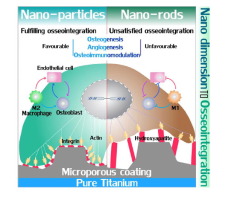Acta Biomaterialia ( IF 9.4 ) Pub Date : 2018-06-15 , DOI: 10.1016/j.actbio.2018.06.023 Long Bai , Yanlian Liu , Zhibin Du , Zeming Weng , Wei Yao , Xiangyu Zhang , Xiaobo Huang , Xiaohong Yao , Ross Crawford , Ruiqiang Hang , Di Huang , Bin Tang , Yin Xiao

|
Coating materials applied for intraosseous implants must be optimized to stimulate osseointegration. Osseointegration is a temporal and spatial physiological process that not only requires interactions between osteogenesis and angiogenesis but also necessitates a favorable immune microenvironment. It is now well-documented that hierarchical nano-micro surface structures promote the long-term stability of implants, the interactions between nano-micro structure and the immune response are largely unknown. Here, we report the effects of microporous titanium (Ti) surfaces coated with nano-hydroxyapatite (HA) produced by micro-arc oxidation and steam-hydrothermal treatment (SHT) on multiple cell behavior and osseointegration. By altering the processing time of SHT it was possible to shift HA structures from nano-particles to nano-rods on the microporous Ti surfaces. Ti surfaces coated with HA nano-particles were found to modulate the inflammatory response resulting in an osteoimmune microenvironment more favorable for osteo-/angio-genesis, most likely via the activation of certain key signaling pathways (TGF-β, OPG/RANKL, and VEGF). By contrast, Ti surfaces coated with nano-rod shaped HA particles had a negative impact on osteo-/angio-genesis and osteoimmunomodulation. In vivo results further demonstrated that Ti implant surfaces decorated with HA nano-particles can stimulate new bone formation and osseointegration with enhanced interaction between osteocytes and implant surfaces.This study demonstrated that Ti implants with micro-surfaces coated with nano-particle shaped HA have a positive impact on osseointegration.
Statement of Significance
Osteo-/angio-genesis are of importance during osteointegration of the implants. Recent advances unravel that immune response of macrophages and its manipulated osteoimmunomodulation also exerts a pivotal role to determine the fate of the implant. Surface nano-micro modification has evidenced to be efficient to influence osteogenesis, however, little is known links nano-microstructured surface to immune response, as well the osteoimmunomodulation. This study demonstrates that the nano-particles decorated micro-surface, compared with the nano-rods decorated micro-surface enables osteogenesis and angiogenesis concurrently that has not been investigated previously. This study also unravels that the immune response of macrophages can be manipulated by the nano-micro surface, especially the nano-dimension matters, leading to a differential effect on osteointegration. The additional knowledge obtained from this study may provide foundation and reference for future design of the coating materials for implantable materials.
中文翻译:

羟基磷灰石纳米颗粒与纳米棒修饰的钛微表面对骨整合的差异作用
必须优化用于骨内植入物的涂层材料,以刺激骨整合。骨整合是一个时间和空间生理过程,不仅需要成骨和血管生成之间的相互作用,而且还需要良好的免疫微环境。现已有文献证明,分层的纳米微表面结构促进了植入物的长期稳定性,纳米微结构与免疫反应之间的相互作用在很大程度上尚不清楚。在这里,我们报告微弧氧化和蒸汽水热处理(SHT)产生的纳米羟基磷灰石(HA)涂层的微孔钛(Ti)表面对多细胞行为和骨整合的影响。通过改变SHT的处理时间,可以将HA结构从纳米颗粒转移到微孔Ti表面上的纳米棒。发现涂有HA纳米颗粒的Ti表面可调节炎症反应,从而导致更有利于骨/血管生成的骨免疫微环境通过某些关键信号通路(TGF-β,OPG / RANKL和VEGF)的激活。相比之下,涂有纳米棒状HA颗粒的Ti表面对骨/血管生成和骨免疫调节有负面影响。体内结果进一步证明,用HA纳米颗粒装饰的Ti植入物表面可以刺激新的骨形成和骨整合,并增强骨细胞与植入物表面之间的相互作用。对骨整合的积极影响。
重要声明
骨/血管生成在植入物的骨整合过程中很重要。最近的进展表明,巨噬细胞的免疫应答及其可调节的骨免疫调节作用也起着决定植入物命运的关键作用。表面纳米微修饰已被证明能有效地影响成骨作用,但是,几乎没有人知道将纳米微结构的表面与免疫反应以及骨免疫调节联系起来。这项研究表明,与纳米棒修饰的微表面相比,纳米颗粒修饰的微表面能够同时实现成骨和血管生成,这是以前没有研究过的。这项研究还揭示了巨噬细胞的免疫反应可以被纳米微表面操纵,尤其是纳米尺寸的物质,导致对骨整合的差异化作用。从这项研究中获得的其他知识可以为可植入材料的涂层材料的未来设计提供基础和参考。











































 京公网安备 11010802027423号
京公网安备 11010802027423号